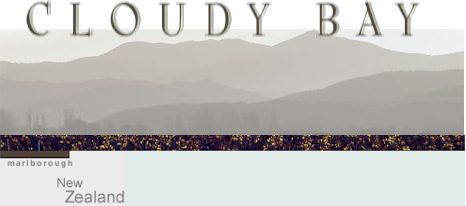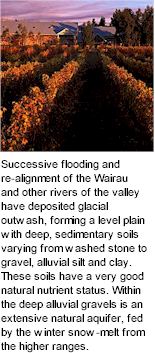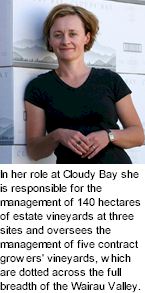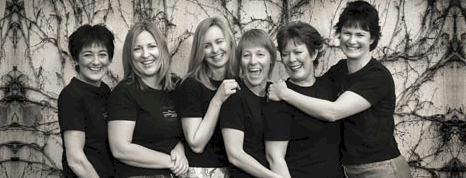


Cloudy Bay farms 200 hectares of vines at three carefully selected sites. Vineyards planted in 1986 surround the winery in the Wairau Valley at Rapaura, with additional plantings at nearby Renwick and in the Brancott & Omaka Valley's, in the southern foothills. Five long term contract growers also work closely with Cloudy Bay. The main varieties grown are sauvignon blanc, chardonnay and pinot noir with lesser quantities of riesling and gewurztraminer.

Cloudy Bay takes its name from the bay at the eastern extremity of the Wairau Valley. It was named Cloudy Bay by Captain Cook on his voyage to New Zealand in 1770. The wines of Cloudy Bay are exported to more than 30 countries worldwide, the principal markets being Australia, United Kingdom, USA, Europe and Japan. Cloudy Bay will continue to expand its operations and the company believes that the continued success of Marlborough lies in the production of premium wines from varieties best suited to the region.
The Wairau Valley of Marlborough is synonymous with the world's finest sauvignon blanc and it was this variety that inspired the establishment of Cloudy Bay Vineyards in 1985. Cloudy Bay Sauvignon Blanc played a significant role in establishing this international reputation and is consistently regarded as one of the region's finest. The Cloudy Bay team combine meticulous viticulture, modern winemaking technology and traditional vinification techniques to produce a style notable for its structure, complexity and fine balance. Cloudy Bay Sauvignon Blanc is an elegant aromatic wine with appealing fruit and crisp acidity.
Pelorus is the premium quality sparkling wine label of Cloudy Bay Vineyards. It is produced from chardonnay and pinot noir sourced from selected sites within the Wairau Valley. Sunny skies and the long cool summer days of these southerly latitudes ensure the slow ripening essential for achieving the elegance, crispness and complexity inherent in a quality sparkling wine. Pelorus NV is a chardonnay based blend of selected vintages, aged in the bottle for two years on yeast lees. Pelorus Vintage is a blend of pinot noir and chardonnay. Traditional vinification techniques including barrel fermentation, oak maturation and malolactic fermentation are used to complement contemporary winemaking skills in the crafting of this wine.

Cloudy Bay Te Koko is an individual expression of the sauvignon blanc grape, a complex and savoury wine that is both deliciously aromatic and richly textured. Aromas of lychee and honeysuckle intermingle with the scent of thyme and a hint of smoky oak. Released as a matured wine, Te Koko is a full-bodied, alternative style of sauvignon blanc ... a complimentary addition to the Cloudy Bay range.
The winemaking philosophy of Te Koko is very much 'hands off', and is the result of winemaking curiosity, having employed similar techniques with chardonnay. After harvesting and pressing, the juice is transferred to French oak barrels and allowed to undergo fermentation using naturally occurring yeast. This primary fermentation is subsequently followed by a full malolactic fermentation in the following spring. The wine is left in barrel, on yeast lees for 18 months prior to bottling.
The bay at the Eastern extremity of the Wairau Valley, named 'Cloudy Bay' by Captain Cook, was originally known as 'Te Koko - o - Kupe' by the Maori people of the region. Legend has it that Kupe, the Tahitian explorer dredged for oysters in the bay and Te Koko refers to the scoop used by Kupe to lift the oysters from the seabed. Traditional vinification methods are employed to produce an intriguing and complex wine. These include, wild yeast and malolactic fermentations, prolonged contact with yeast lees and ageing in French oak barriques. Alcohol levels are naturally high and produce a wine with body and viscosity. The dominant fruit characters of melon and peach blend harmoniously with toasty vanillin oak and mealy yeast autolysis characters.
Pinot noir thrives in Marlborough where Cloudy Bay has planted the best clones in prime vineyard locations to produce the highest quality fruit. Crop levels are carefully controlled to ensure the grapes have great concentration of flavour and this is enhanced by tried and true 'hands off' winemaking practices. Cloudy Bay's Late Harvest Riesling is made only when optimum conditions prevail, the grapes are hand picked from bare canes in late autumn. Sapped almost dry by the botrytis fungus, the wine is lusciously fruity and sweet.
In July 2003, Lecturer in Oenology Dr. Tony Jordan, taking over from founder David Hohnen, was appointed to the position of Chief Executive Officer of Cape Mentelle, Cloudy Bay and Mountadam, the Australian and New Zealand wineries within the Veuve Clicquot Ponsardin Group, which is also a part of the Moet-Hennessy Louis Vuitton Group. This position is in addition to Tony's role as CEO of Domaine Chandon Australia (Chandon and Green Point brands).
